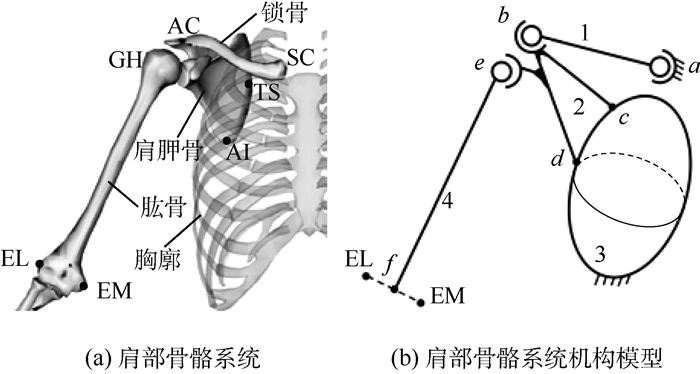A shoulder skeletal kinematic model based on spatial hybrid mechanism
-
摘要:
为了描述人体肩部骨骼系统的运动特征,将肩胛骨与胸廓的相对运动关系定义为类似于圆柱-平面副的运动约束,建立了肩部骨骼系统的空间混联机构模型。首先定义了肩部复合体各关节的类型,并完成了肩带部分和整个肩部机构的自由度分析。然后通过定义附着于各骨骼上的局部坐标系,以齐次坐标变换矩阵和矢量法建立机构的运动分析方程,求得其关节位置的闭合解。最后为了验证该模型,以获得自肩部运动实验的骨骼姿态数据反向驱动该机构模型,从而得到肩胛骨姿态的计算结果,并与测量结果进行对比。结果表明:该机构模型能够反映肩部骨骼的运动约束关系。同时,该模型可以通过缩放处理从而用于适应不同个体的骨骼几何特征。
Abstract:In order to represent the movement of the shoulder skeletal system, a spatial hybrid mechanism model is proposed, which describes the articulation between the scapula and thorax as a kinematic constraint similar to a cylinder-plane pair. Firstly, types of joints in shoulder are determined, and thus the degrees of freedom of the shoulder girdle and shoulder mechanism can be analyzed. After the definition of local coordinate systems attached to each skeleton, the vector theory method and homogeneous coordinate transformation are used to establish the position analysis equation of the shoulder mechanism, and the closed-form solutions of joint positions are obtained subsequently. Finally, to verify the validity of the mechanism model, the skeletal posture dataset obtained from a shoulder movement experiment is used to inversely drive the model, the calculation results of the scapular posture are compared with the experimental data. The results indicate that the mechanism model has achieved a good consistency in predicting the skeletal movement of the shoulder complex. Furthermore, this model can be adapted for different individuals' geometric skeletal characteristics by scaling.
-
表 1 标准模型的各构件尺寸参数
Table 1. Size parameters of each link in generic model
参数 l1 /mm l2 /mm l3 /mm l22 /mm l4 /mm γ /(°) 数值 182.5 129.1 185.9 117.6 301.6 38.8 表 2 标准模型中胸廓椭球的几何尺寸
Table 2. Size parameters of thorax ellipsoid in generic modelmm
几何尺寸 c1 c2 c3 O点位置0pO e点位置2pe 数值 144.6 95.6 211.7 [0-62.1
-152.1 1]T[28.1-43.9
-164.5 1]T表 3 实验对象的骨骼特征尺寸参数
Table 3. Skeletal size parameters of experimental subjectmm
骨骼标记点 标准模型 实验对象 IJ (0, 0, 0) (0, 0, 0) PX (31.9, -132.7, -9.8) (56.0, -163.0, -2.4) C7 (-124.2, 54.1, 0) (-123.1, 80.7, -4.7) T8 (-156.61, -171.5, 0) (-179.1, -133.2, 11.2) AA (-105.6, 7.5, 182.6) (-73.5, 9.3, 205.1) TS (-156.0, -11.7, 75.0) (-136.3, 5.1, 121.8) AI (-156.7, -126.2, 101.9) (-141.6, -126.5, 116.2) AC (-71.8, 26.6, 165.1) (-37.0, 40.4, 167.2) SC (-2.8, -15.2, 1.4) (15.3, -31.0, -6.6) 椭球中心 (-62.1, -152.1, 0) (-61.6, -148.1, 0) 椭球半轴 (95.6, 211.7, 144.6) (114.4, 222.7, 164.8) -
[1] YANG J, FENG X, KIM J H, et al.Review of biomechanical models for human shoulder complex[J]. International Journal of Human Factors Modelling & Simulation, 2010, 1(3):271-293. [2] YANG J J, FENG X, XIANG Y, et al.Determining the three-dimensional relation between the skeletal elements of the human shoulder complex[J]. Journal of Biomechanics, 2009, 42(11):1762-1767. doi: 10.1016/j.jbiomech.2009.04.048 [3] DEMPSTER W T.Mechanisms of shoulder movement[J]. Archives of Physical Medicine & Rehabilitation, 1965, 46:49-70. [4] ENGIN A E, CHEN S M.Statistical data base for the biomechanical properties of the human shoulder complex-Ⅰ:Kinematics of the shoulder complex[J]. Journal of Biomechanical Engineering, 1986, 108(3):215-221. doi: 10.1115/1.3138605 [5] ENGIN A E, TUMER S T.Three-dimensional kinematic modelling of the human shoulder complex-Part Ⅰ:Physical model and determination of joint sinus cones[J]. Journal of Biomechanical Engineering, 1989, 111(2):107-112. doi: 10.1115/1.3168351 [6] XU X, DICKERSON C R, LIN J H, et al.Evaluation of regression-based 3-D shoulder rhythms[J]. Journal of Electromyography and Kinesiology, 2015, 17:28-33. [7] MASO F D, BLACHE Y, RAISON M, et al.Glenohumeral joint kinematics measured by intracortical pins, reflective markers, and computed tomography:A novel technique to assess acromiohumeral distance[J]. Journal of Electromyography and Kinesiology, 2015, 29:4-11. [8] HARISH V, BAKSH A, UNGI T, et al.Measurement of electromagnetic tracking error in a navigated breast surgery setup[C]//Proceedings of the SPIE Medical Imaging.Bellingham:SPIE Press, 2016, 9786:1-8. [9] ZHANG C, SKALLI W, LAGAC P Y, et al.Investigation of 3D glenohumeral displacements from 3D reconstruction using biplane X-ray images:Accuracy and reproducibility of the technique and preliminary analysis in rotator cuff tear patients[J]. Landscape Design Journal of the Landscape Institute, 2015, 29(10):12-20. [10] DAL M F, RAISON M, LUNDBERG A, et al.Glenohumeral translations during range-of-motion movements, activities of daily living, and sports activities in healthy participants[J]. Clinical Biomechanics, 2015, 30(9):1002-1007. doi: 10.1016/j.clinbiomech.2015.06.016 [11] GARNER B A, PANDY M G.Musculoskeletal model of the upper limb based on the visible human male dataset[J]. Computer Methods in Biomechanics & Biomedical Engineering 2001, 4(2):93-126. [12] MAUREL W, THALMANN D.Human sholder modeling including scapulo-thoracic constraint and joint sinus cones[J]. Computers & Graphics, 2000, 24(2):203-218. [13] MAUREL W, THALMANN D, HOFFMEYER P, et al.A biomechanical musculoskeletal model of human upper limb for dynamic simulation[C]//Proceedings of the Eurographics Workshop on Computer Animation and Simulation.Vienna:Springer, 1996:121-136. [14] TONDU B.Modelling of the shoulder complex and application the design of upper extremities for humanoid robots[C]//Proceedings of the IEEE-Ras International Conference on Humanoid Robots.Piscataway, NJ:IEEE Press, 2005:313-320. [15] BOLSTERLEE B, VEEGER H E J.Modelling clavicular and scapular kinematics:From measurement to simulation[J]. Medical & Biological Engineering & Computing, 2014, 52(3):283-291. [16] SHOLUKHA V, JAN S V S.Combined motions of the shoulder joint complex for model-based simulation:Modeling of the shoulder rhythm(ShRm)[M]. London:Springer, 2014:205-232. [17] WARNER M B, CHAPPELL P H, STOKES M J.Measurement of dynamic scapular kinematics using an acromion marker cluster to minimize skin movement artifact[J]. Journal of Visualized Experiments Jove, 2015, 96:e51717. [18] The National Center for Simulation in Rehabilitation Research(NCSRR).Shoulder movements database:The supplement of Delft Shoulder and Elbow Model Project[DS/OL]. (2015-03-20)[2016-05-30]. [19] WU G, HELM F C T V D, VEEGER H E J, et al.ISB recommendation on definitions of joint coordinate systems of various joints for the reporting of human joint motion-Part Ⅱ:Shoulder, elbow, wrist and hand[J]. Journal of Biomechanics, 2005, 38(5):981-992. doi: 10.1016/j.jbiomech.2004.05.042 [20] GARNER B A, PANDY M G.A kinematic model of the upper limb based on the visible human project (VHP) image dataset[J]. Computer Methods in Biomechanics & Biomedical Engineering, 1999, 2(2):107-124. -







 下载:
下载:















